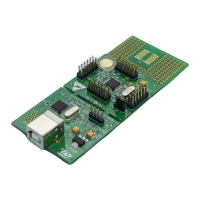Recommendations AN2752
16/40 AN2752 Rev 6
6 Recommendations
6.1 Printed circuit board
For technical reasons, the best option is to use a multi-layer PCB with a separate layer
dedicated to V
SS
and another layer to V
DD
supply, which results in a good decoupling, as
well as a good shielding effect. For many applications, economical requirements forbid the
use of this type of board. In this case, the most important feature is to ensure a good
structure for the V
SS
and power supply.
6.2 Component position
A preliminary layout of the PCB must separate the different circuits according to their
electromagnetic interference (EMI) contribution in order to reduce cross-coupling on the
PCB, i.e. noisy, high-current circuits, low voltage circuits, and digital components.
6.3 Ground and power supply (V
SS
, V
DD
)
The V
SS
has to be distributed individually to every block (noisy, low level sensitive, and
digital) with a single point for gathering all ground returns. Loops must be avoided or have a
minimum surface. The power supply needs to be close to the ground line to minimize the
surface of the supply loop. This is due to the fact that the supply loop acts as an antenna,
and is therefore the main emitter and receiver of EMI. All component-free surfaces of the
PCB must be filled with additional grounding to create a kind of shield (especially when
using single-layer PCBs).
6.4 Decoupling
The standard decoupler for the external power is a 100 µF pool capacitor. Supplementary
100 nF capacitors must be placed as close as possible to the VSS/VDD pins to reduce the
area of the current loop.
As a general rule, decoupling all sensitive or noisy signals improves electromagnetic
compatibility (EMC) performance.
There are two types of decouplers:
• Capacitors close to components. Inductive characteristics, which apply to all capacitors
beyond a certain frequency, must be taken into account. If possible, use parallel
capacitors with decreasing values (0.1, 0.01, ... µF).
• Inductors. Although often ignored, ferrite beads, for example, are excellent inductors
due to their good dissipation of EMI energy and there is no loss of DC voltage (which is
not the case when simple resistors are used).

